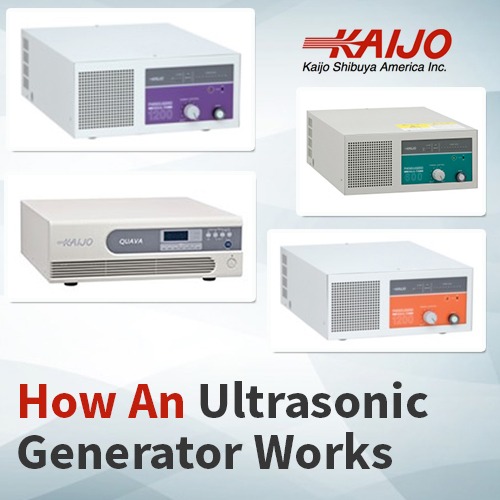How an Ultrasonic Generator Works
August 17, 2017
 The ultrasonic generator is at the heart of ultrasonic cleaning systems as it produces the high-frequency signal that the ultrasonic transducers convert to sound waves in the cleaning solution. In addition to generating the signal, the unit can control the frequency and the power, produce several or a range of frequencies and act as part of an integrated, turnkey solution or independently to power separate transducers. Ultrasonic generators need to be selected to match specific cleaning requirements in order for the system to work effectively. Key criteria for generator selection are the power and frequency of the generator and the matching transducers. In each case, the cleaning tank has to be large enough to hold the longest part to be cleaned, the power has to be high enough for the tank size and the frequency has to match the type of contaminant and the mechanical strength of the parts to be cleaned.
The ultrasonic generator is at the heart of ultrasonic cleaning systems as it produces the high-frequency signal that the ultrasonic transducers convert to sound waves in the cleaning solution. In addition to generating the signal, the unit can control the frequency and the power, produce several or a range of frequencies and act as part of an integrated, turnkey solution or independently to power separate transducers. Ultrasonic generators need to be selected to match specific cleaning requirements in order for the system to work effectively. Key criteria for generator selection are the power and frequency of the generator and the matching transducers. In each case, the cleaning tank has to be large enough to hold the longest part to be cleaned, the power has to be high enough for the tank size and the frequency has to match the type of contaminant and the mechanical strength of the parts to be cleaned.
How the Generator Works
An ultrasonic generator uses 60 Hz electrical utility power to create frequencies ranging from about 20 kHz to the 1 MHz range. Some models can generate only a single or a few frequencies while others can produce a wide range. Different levels of power are also available. For multiple-frequency models, operators can select the frequency that is most appropriate for their cleaning application.
In addition to producing the high-frequency signal, ultrasonic generators control the signal to maximize cleaning performance. Generators may automatically adjust the signal to compensate for heavy or light loading of the cleaning tank and they may “sweep” the signal, varying the frequency slightly to eliminate resonance or standing waves in the cleaning tank. For example, when a generator is operating at 38 kHz, varying the frequency randomly between 36 and 40 kHz eliminates hot spots and tank resonance that could damage the parts to be cleaned.
Selecting the Right Model
Choosing the right frequency for the application is the key to effective ultrasonic cleaning. Low frequencies in the 26 to 38 kHz range produce large, energetic cavitation bubbles in the cleaning solution. The cleaning action is powerful but fragile components may be damaged and soft surfaces may suffer pitting. This range is suitable for items such as machined parts, glass and wires.
For the mid-frequency range of 78 to 160 kHz, the cavitation bubbles are smaller and the cleaning action is gentler. Hard disk drives, solar panels and ceramic parts can be cleaned at these frequencies. The most delicate components can be cleaned at the highest frequency ranges of 450 to 950 kHz. These frequencies are suitable for semiconductors, LEDs and fragile medical components.
If the ultrasonic generator is used with a single process and always has to clean the same kind of parts, selecting a single-frequency model makes sense. For general-purpose facilities, where the ultrasonic cleaning system may be used for many different cleaning applications, a generator that can produce many frequencies is a good choice.
Kaijo has a complete line of ultrasonic generators and offers free consulting to make sure customers select the type of system best suited to their cleaning applications. Generator models include the Quava high power, the Quava Mini and the Phenix Legend. Models are available as separate components or in complete turnkey systems.
The Quava high power ultrasonic generators that can operate at either multi-frequencies of 26/78/130 kHz or 38/100/160 kHz or ten different single frequency systems from 26 to 950 kHz. The Quava mini is a self-contained, compact tabletop system for small cleaning jobs. The Phenix Legend has 4 single frequency systems of 78kHz, 100kHz, 130kHz and 160kHz. Contact Kaijo for a free quote or consultation in selecting the right equipment components for your specific cleaning application.





